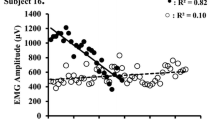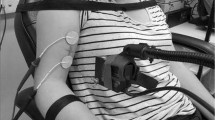Abstract
Purpose
We investigated the effect of resistance training and detraining on the spatial distribution pattern of surface electromyography (SEMG) of the biceps brachii.
Methods
Ten male subjects completed 6 weeks of resistance training of one arm and 8 weeks of detraining. During training and detraining periods, spatial distribution patterns of SEMG were measured and quantified with 64 two-dimensional electrodes.
Results
MVC, muscle thickness, and SEMG amplitude of the trained arm were significantly greater than those of the untrained arm after the 6 weeks of resistance training (p < 0.05), but these differences were no longer observed after 2 months of detraining. On the other hand, no significant differences in the spatial distribution pattern of SEMG were observed between the arms.
Conclusion
Spatial distribution pattern of SEMG was not changed during resistance training and detraining periods. This suggests that detectable adaptations in the motor unit recruitment pattern do not occur during regular resistance training.




Similar content being viewed by others
Abbreviations
- ARV:
-
Average rectified value
- BB:
-
Biceps brachii
- SEMG:
-
Surface electromyography
- MVC:
-
Maximal voluntary contraction
- MU:
-
Motor unit
- 1RM:
-
One repetition maximum,
References
Akima H, Takahashi H, Kuno SY, Masuda K, Masuda T, Shimojo H et al (1999) Early phase adaptations of muscle use and strength to isokinetic training. Med Sci Sports Exerc 31:588–594
Blazevich AJ, Gill ND, Deans N, Zhou S (2007) Lack of human muscle architectural adaptation after short-term strength training. Muscle Nerve 35:78–86
Chanaud CM, Macpherson JM (1991) Functionally complex muscles of the cat hindlimb. III. Differential activation within biceps femoris during postural perturbations. Exp Brain Res 85:271–280
Erim Z, De Luca CJ, Mineo K, Aoki T (1996) Rank-ordered regulation of motor units. Muscle Nerve 19:563–573
Farina D, Merletti R, Enoka RM (2004) The extraction of neural strategies from the surface EMG. J Appl Physiol 96:1486–1495
Farina D, Leclerc F, Arendt-Nielsen L, Buttelli O, Madeleine P (2008) The change in spatial distribution of upper trapezius muscle activity is correlated to contraction duration. J Electromyogr Kinesiol 18:16–25
Farina D, Holobar A, Merletti R, Enoka RM (2010) Decoding the neural drive to muscles from the surface electromyogram. Clin Neurophysiol 121:1616–1623
Gabriel DA, Kamen G, Frost G (2006) Neural adaptations to resistive exercise: mechanisms and recommendations for training practices. Sports Med 36:133–149
Gallina A, Merletti R, Gazzoni M (2013) Uneven spatial distribution of surface EMG: what does it mean? Eur J Appl Physiol 113:887–894
Hakkinen K, Komi PV (1983) Electromyographic changes during strength training and detraining. Med Sci Sports Exerc 15:455–460
Hakkinen K, Newton RU, Gordon SE, McCormick M, Volek JS, Nindl BC et al (1998) Changes in muscle morphology, electromyographic activity, and force production characteristics during progressive strength training in young and older men. J Gerontol A Biol Sci Med Sci 53:B415–B423
Holtermann A, Gronlund C (2008) Stefan Karlsson J, Roeleveld K. Spatial distribution of active muscle fibre characteristics in the upper trapezius muscle and its dependency on contraction level and duration. J Electromyogr Kinesiol 18:372–381
Holtermann A, Roeleveld K (2006) EMG amplitude distribution changes over the upper trapezius muscle are similar in sustained and ramp contractions. Acta Physiol 186:159–168
Holtermann A, Roeleveld K, Karlsson JS (2005) Inhomogeneities in muscle activation reveal motor unit recruitment. J Electromyogr Kinesiol 15:131–137
Holtermann A, Gronlund C, Karlsson JS, Roeleveld K (2008) Differential activation of regions within the biceps brachii muscle during fatigue. Acta physiologica (Oxford, England) 192:559–567
Holtermann A, Roeleveld K, Mork PJ, Gronlund C, Karlsson JS, Andersen LL et al (2009) Selective activation of neuromuscular compartments within the human trapezius muscle. J Electromyogr Kinesiol 19:896–902
Houston ME, Froese EA, Valeriote SP, Green HJ, Ranney DA (1983) Muscle performance, morphology and metabolic capacity during strength training and detraining: a one leg model. Eur J Appl Physiol 51:25–35
Hubal MJ, Gordish-Dressman H, Thompson PD, Price TB, Hoffman EP, Angelopoulos TJ et al (2005) Variability in muscle size and strength gain after unilateral resistance training. Med Sci Sports Exerc 37:964–972
Kamen G (2005) Aging, resistance training, and motor unit discharge behavior. Can J Appl Physiol 30:341–351
Kamen G, Knight CA (2004) Training-related adaptations in motor unit discharge rate in young and older adults. J Gerontol A Biol Sci Med Sci 59:1334–1338
Komi PV, Viitasalo JT, Rauramaa R, Vihko V (1978) Effect of isometric strength training of mechanical, electrical, and metabolic aspects of muscle function. Eur J Appl Physiol 40:45–55
Kraemer WJ, Ratamess NA (2004) Fundamentals of resistance training: progression and exercise prescription. Med Sci Sports Exerc 36:674–688
Krentz JR, Farthing JP (2010) Neural and morphological changes in response to a 20-day intense eccentric training protocol. Eur J Appl Physiol 110:333–340
Lexell J, Downham DY (1991) The occurrence of fibre-type grouping in healthy human muscle: a quantitative study of cross-sections of whole vastus lateralis from men between 15 and 83 years. Acta Neuropathol 81:377–381
Merletti R, Holobar A, Farina D (2008) Analysis of motor units with high-density surface electromyography. J Electromyogr Kinesiol 18:879–890
Moritani T, deVries HA (1979) Neural factors versus hypertrophy in the time course of muscle strength gain. Am J Phys Med 58:115–130
Narici MV, Roi GS, Landoni L, Minetti AE, Cerretelli P (1989) Changes in force, cross-sectional area and neural activation during strength training and detraining of the human quadriceps. Eur J Appl Physiol 59:310–319
Tucker K, Falla D, Graven-Nielsen T, Farina D (2009) Electromyographic mapping of the erector spinae muscle with varying load and during sustained contraction. J Electromyogr Kinesiol 19:373–379
Van Cutsem M, Duchateau J, Hainaut K (1998) Changes in single motor unit behaviour contribute to the increase in contraction speed after dynamic training in humans. J Physiol 513(Pt 1):295–305
Vila-Cha C, Falla D, Farina D (2010) Motor unit behavior during submaximal contractions following 6 weeks of either endurance or strength training. J Appl Physiol 109:1455–1466
Watanabe K, Kouzaki M, Fujibayashi M, Merletti R, Moritani T (2012a) Spatial EMG potential distribution pattern of vastus lateralis muscle during isometric knee extension in young and elderly men. J Electromyogr Kinesiol 22:74–79
Watanabe K, Miyamoto T, Tanaka Y, Fukuda K, Moritani T (2012b) Type 2 diabetes mellitus patients manifest characteristic spatial EMG potential distribution pattern during sustained isometric contraction. Diabetes Res Clin Pract 97:468–473
Acknowledgments
This research was supported by JSPS KAKENHI, a Grant-Aid for Research Activity Start-up (No. 24800071) and Japanese Council for Science, Technology and Innovation (CSTI), Cross-ministerial Strategic Innovation Promotion Program (SIP Project ID 14533567).
Author information
Authors and Affiliations
Corresponding author
Additional information
Communicated by Nicolas Place.
Rights and permissions
About this article
Cite this article
Watanabe, K., Kouzaki, M. & Moritani, T. Spatial EMG potential distribution of biceps brachii muscle during resistance training and detraining. Eur J Appl Physiol 115, 2661–2670 (2015). https://doi.org/10.1007/s00421-015-3237-2
Received:
Accepted:
Published:
Issue Date:
DOI: https://doi.org/10.1007/s00421-015-3237-2




